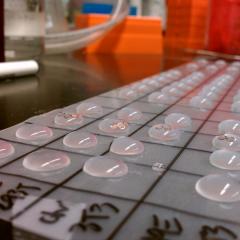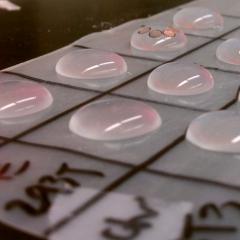Communication between cells is fundamental to almost every event in the life of multicellular organisms. Cell-cell signaling plays a critical role in both developing embryos and in adults. The Hedgehog pathway is highly conserved in metazoans and has essential roles in many developmental processes. In adult tissues, Hedgehog signaling is required for stem cell maintenance while increased Hedgehog signaling is deeply implicated in human cancer. We are using biochemistry, cell and chemical biology to elucidate how vertebrate cells send and respond to Hedgehog signals. Two key aspects we are currently investigating are the activation of the secreted Hedgehog protein and the regulated proteolysis of Gli, the transcriptional effector of the Hedghog pathway. We also develop and apply new chemical and optical technology within the area of cell-cell signaling and cell cycle.
Research
1) How is the Hedgehog protein activated?
Hedgehog, a secreted protein, becomes active through a unique posttranslational process involving the attachment of both cholesterol and palmitate. We are using biochemistry to reconstitute these complex reactions and dissect their mechanism. We also use live cell imaging to investigate the subcellular dynamics of Hedgehog activation, to determine when and where during passage through the secretory pathway Hedgehog processing occurs.
2) How does Hedgehog signaling control the transcription factor Gli?
In the absence of a Hedgehog signal, the transcription factor Gli is phosphorylated, ubiquitylated and then proteolyzed to a truncated form that has dominant-negative activity. Hedgehog pathway activation somehow blocks Gli proteolysis, resulting in the accumulation of full-length Gli and activation of target gene transcription. How are the vertebrate Gli's proteolyzed in the resting state of th Hedgehog pathway? How does Hedgehog signaling block Gli proteolysis? We are using biochemical reconstitution and cell biology to answer these questions. We are also using live cell imaging to understand the spatial and temporal aspects of Gli proteolysis in both the resting and the stimulated states of the Hedgehog pathway.
3) Are other proteins regulated by cholesterol modification?
Hedgehog is so far the only known protein modified by cholesterol; there is, however evidence for the existence of other cholesterol-modified proteins in vertebrates. We are using expression cloning as well as chemical biology approaches to identify other cholesterol-modified proteins and study them functionally in cells. We are also interested in understanding how cholesterol becomes attached to these proteins.
4) Novel chemical tools to study cell-cell signaling and chromosome segregation
Many interactions between components involved in cell-cell signaling are highly dynamic, making them difficult to study by standard biochemical techniques. To circumvent this problem, in collaboration with Stephen Miller (UMass Medical Center) we develop novel site-specific crosslinkers to assay dynamic protein-protein interactions in vivo. We are also interested in high-resolution imaging of chromosomes, using a novel chemical method we developed to label DNA in cells. This method is faster, more sensitive and less disruptive than currently available methods, allowing for superior ultrastructural investigations.



